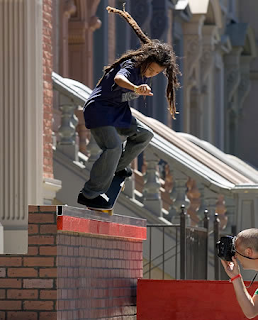After learning random facts and what to consider before
going through with the commitment of dreading your hair, I think it’s time to
let you all in on a little secret… Today I will be focusing on how to start
your locks. If my last post didn’t make you freak out and decide against such
an experiential journey, I solute you. Let’s get started.
To begin the process, you’ll need to know which method you
would like to use when creating your dreadlocks. Remember what I’ve told you in
previous blog posts; this is a commitment, and the progression of beginning
dreadlocks takes patience and time. You will not have ‘dreadlocks’ as soon as
you begin them. Your hair is instead going to be fluffy sections of hair. According to a health article found on beauty.about.com, the average human
(with no abnormally excessive hair loss) sheds between 40 and 120 hairs a day
based on how thick or thin his/her hair is. What creates the hair to lock, or
knot up, resulting in actual dreadlocks is the buildup of these hairs. The hair
that the average human sheds a day does not fall off of the head of a person
with dreadlocks. Instead, the loose hairs lock in with the hair connected to
the scalp and the sections of hair mature forming a firm, completely locked
section of hair also known as a dreadlock.
The methods you can use to start this journey include:
-Neglect Dreads
-Backcombed Dreads
-Twist n’ Rip Dreads
Neglect Method
Neglect-forming dreadlocks are probably the easiest method
to creating dreadlocks. To create neglected dreadlocks, you simply must neglect your
hair. There is no sectioning involved.
Throw away your hairbrushes, your combs, and your hair products and let your
hair do what it wants. The dreadlocks free form as they wish, which can result
in very unruly, chaotic knots. The dreads take much longer to form than they do
with the other methods, and the sizes are all completely different. I have met
some people who have started their dreadlocks with this method, and they have
chosen not to wash their hair. I advise against the idea to let your hair go
completely. Personal hygiene is important, and even if you wash your hair, your
neglected dreadlocks will form just as fast, if not faster. If you need to be
professional at any time, I would advise against neglect-forming dreadlocks.
Here is a photo of neglected dreadlocks after 9 months. Photo courtesy of dreadlockssite.com
Backcombing Method
Sectioning off your scalp is how you want to start
backcombed dreadlocks. Choosing how big to make your sections is important
because this is how big your dreadlocks will be. The more sections you create,
the smaller your dreadlocks are. It’s a nice touch to make some sections
big and some small, just so that you have some form of variation, unless you
want to shoot for perfectly symmetrical dreadlocks, in which case- I wish you
luck! Instead of sectioning my hair in symmetrical parts like a tic tac toe
board, I chose to section them in a staggering fashion comparable to a brick
wall much like the photo below (courtesy
of klixer.com). To help keep the hair in sections and out of your way, you
can use clips or rubber bands to hold them in place.
Once your hair is sectioned, you will go one section at a
time. It’s easier to move from neck to forehead. Remove the rubber band, and
using a metal comb, comb backwards. Combing from the middle of the hair
toward the scalp will create small bushy sections of hair like in the picture
below (courtesy of ragingrootsstudio.com).
Do not be afraid to put some elbow into it.
Once you have backcombed from scalp to end of hair, you will
‘palm roll’ your new baby dread. To do this, place the hair between your palms,
apply pressure and rub your palms together fast, moving from the scalp to the
end. This will create friction and help smooth the teased hair down as well as
round out the sectioned hair. Repeat for each section of hair you have.
Twist n’ Rip Method
This method is a bit harder to conquer if you have never
attempted it before, but is one of the best ways to start your dreads. It is
argued that this method is damaging to your hair, but I can assure you through
endless research, it is no more damaging than any other dreadlock method. To
begin this method, you will section off your hair just like you would if you
were backcombing. Once your hair is secured in sections, take one section of
hair in your hands. Separate the section in two halves and pull toward the
roots, creating knots close to the scalp. Twist the entire section as a whole
and randomly select two halves from the same section. Pull the halves in
opposite directions toward the scalp and repeat until you have created a build
up of knots the entire way down completing the section. Palm roll to finish! Incase that was
hard to follow, or you are a visual learner, take a look at this video!
Be patient with your newly formed hair. They will not
transform over night. Palm rolling a few times a week will help with frizzy
hair, but ultimately you must let go and let your dreads take their course.
Stay tuned next week for more From the
Desk of Dreadhead!








